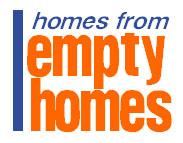Empty Homes Agency on:
[Wikipedia]
[Google]
[Amazon]
 The Empty Homes Agency was established in 1992 by Antony Fletcher with assistance from
The Empty Homes Agency was established in 1992 by Antony Fletcher with assistance from
Empty Homes Agency websiteEmpty Dwellings Management Orders, The Facts, 2006
Empty Homes Agency
Councils to take over empty homes
Empty Homes on BBC Radio 4Empty homes to be demolished 'hidden from figures'
*
Empty Homes Blog
{{Authority control Homelessness charities in the United Kingdom Organizations established in 1992 Charities based in London 1992 establishments in England Housing in the United Kingdom
Serge Lourie
Alexander Serge Lourie CF (22 February 1946 – 10 September 2024) was Leader of the London Borough of Richmond upon Thames, and was a local government councillor there from 1982 to 2010. He was Chairman of the United Kingdom Housing Trust, K ...
as a registered charity in England that works to help people create homes from empty properties and campaigns for more empty homes to be brought into use for the benefit of those in housing need. In 2010 it changed its operational name to Empty Homes. The founding director was Bob Lawrence. In 2018 it changed its name to Action on Empty Homes.
The charity
The Empty Homes Agency is a charitableindustrial and provident society
An industrial and provident society (IPS) is a body corporate registered for carrying on any industries, businesses, or trades specified in or authorised by its rules.
The members of a society benefit from the protection of limited liability ...
, as well as a charitable housing association, and a member of the National Federation of Housing. It is a registered charity in England, No. 27697R, but is registered under the Industrial and Provident Societies Act 1965 and thus not registered with the Charity Commission
The Charity Commission for England and Wales is a non-ministerial department of His Majesty's Government that regulates registered charities in England and Wales and maintains the Central Register of Charities. Its counterparts in Scotland and ...
.
Will McMahon was appointed as Director in May 2018.
Publications
The charity publishes year statistics on the number of empty homes in England. In 2018 Action on Empty Homes estimated that there were 216,000 empty homes in the UK, the highest level for a decade. The charity has also put out numerous publications on how to bring empty properties back into use, for both owners as well as members of the public.Campaigns
The charity highlights the level of housing need in the UK and believes that bringing more empty homes into use provides more homes that in turn helps to ease housing need. The charity has mounted several campaigns aimed at changing government policy to help more empty homes to be brought into use.Empty dwelling management orders
Its successes include successfully lobbying the government to introduce empty dwelling management orders (EDMOs) – legislation to enable local authorities to take over the management control of dwellings that have been empty for six months or more in a forced lease scheme. The legislation caused considerable controversy, although the orders have only been issued a handful of times since the legislation came into practice in 2006.''Cut the VAT''
Empty Homes are part of the Cut the VAT Coalition which believes that reducing VAT from 17.5% to 5% for all maintenance and home improvement work would help the Government achieve its target of cutting carbon emissions by 60% by 2050, as well as encourage the refurbishment and use of empty properties. It has successfully persuaded government to change the rules on VAT, with discounts currently at 5%.Council tax discount
In 2003, Empty Homes successfully lobbied for a campaign to allow councils to reduce of eliminate council tax discounts on empty properties, which David Ireland previously referred to as ‘nonsense’ on the charity's blog.Ongoing campaigns
In 2010 Empty Homes successfully campaigned for additional public spending for bringing empty homes into use. The Government announced that it would allocate £100 million for schemes bringing empty homes into use as part of the comprehensive spending review. Following this funding, academic research has been published on 'empty homes' projects; for example, in 2016 an article in ''Public Money and Management'' which examined the dynamics of a successful collaborative 'empty homes' partnership comprising housing associations, social enterprises and local government.Gillett, A., Loader, K., Doherty, B., & Scott, J. M. (2016). A multi-organizational cross-sectoral collaboration: empirical evidence from an ‘Empty Homes’ project. Public Money & Management, 36(1), 15–22. The charity has been responsible for helping dozens of local authorities set up successful empty property strategies, and in 2010 was asked by theHomes and Communities Agency
Homes England is the non-departmental public body that funds new affordable housing in England. It was founded on 1 January 2018 to replace the Homes and Communities Agency (HCA).
HCA in turn was established by the Housing and Regeneration Act ...
to help administer a comprehensive training programme to help several authorities that were struggling.
References
External links
Empty Homes Agency website
Empty Homes Agency
Councils to take over empty homes
BBC
The British Broadcasting Corporation (BBC) is a British public service broadcaster headquartered at Broadcasting House in London, England. Originally established in 1922 as the British Broadcasting Company, it evolved into its current sta ...
, 24 June 2006 – description of Empty Dwelling Management OrderEmpty Homes on BBC Radio 4
*
Empty Homes Blog
{{Authority control Homelessness charities in the United Kingdom Organizations established in 1992 Charities based in London 1992 establishments in England Housing in the United Kingdom